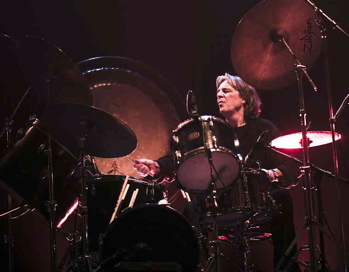Daniel Denis of Univers Zero

Hello, Modern Drummers, Daniel Denis here. This past September, my band Univers Zero [from Belgium] performed its second concert in the USA, in Washington D.C. The first time was in 2004, at NEARfest in Pennsylvania.
As happens every time and everywhere else, in spite of the organizers’ good will, the drumkit I was provided with didn’t exactly match our backline requirements, which can be expected when you play an unusual kit like mine. This is a frequent issue when you can’t bring your own kit along. Cymbals and tom sizes are often disregarded. In general, I take my own cymbals along, but I am not willing to take responsibility for this extra weight when we need to travel by plane. The same goes for my snare drum, which is excellent (a wood Sonor Signature) but isn’t exactly light.
This situation implies that you have to adapt to the kit you are provided with, sometimes without having the time required for adjusting its components in order to obtain a good approximation of your usual sound—for instance, in a festival situation. The “replacement” kit doesn’t necessarily accommodate the kind of fills you usually play on your own kit. So it’s a challenge, and this forces you to play differently and let go of certain clichés you have acquired, which can be a good thing. Advertisement
I often take along my bass drum pedal, a very old DW 5000 with a cork beater, which gives it an energetic sound that’s not as harsh as that of wood beaters. I play a Gretsch bass drum and tom-toms from 1975 and old K Zildjian cymbals made in the ’60s, which I’ve had for a long time: a 22″ ride that keeps getting better with time, a 20″ heavy cymbal, and 14″ hi-hats. Needless to say, all this is usually impossible to find on location. I also use a recent 20″ K Dark ride and a 26″ Wuhan China (the largest model).
I use a gong tom—a Gretsch 20″ bass drum with the back head removed, which is set approximately on an old snare drum stand. I need to tighten the bass drum as hard as possible on the stand and reinforce it with a cast-iron weight; otherwise you can be sure it’ll fall down at one point.
Very often when we perform overseas, people will give me either a concert bass drum that is much too big to match the other toms, or one that’s the right size but has the eternal problem of setting it high up. Advertisement
Recently, a classical/contemporary ensemble, the Sinfonietta Riga from Latvia, performed pieces I’d originally written for UZ but rearranged specifically for the occasion. This was, again, a challenge for me, having no classical training in orchestration. I am self-taught, both as a composer and drummer.
It’s difficult to make a thirty-five-piece ensemble sound right.
I mostly chose pieces where drums weren’t too prominent but instead were played with an orchestral percussion approach. Consequently, the arrangements didn’t require a drummer, but rather three percussionists, for most pieces: a marimba player and two other percussionists who, between them, played toms, cymbals, gongs, bass drums, and other small percussion. I was extremely pleased with the results. You can see a few pictures from the performance on our website, www.univers-zero.com.
When I perform live, I often think of the all-time “master drummer,” Tony Williams. I also wonder what his inspiration would have been like if he’d had to perform UZ material….


